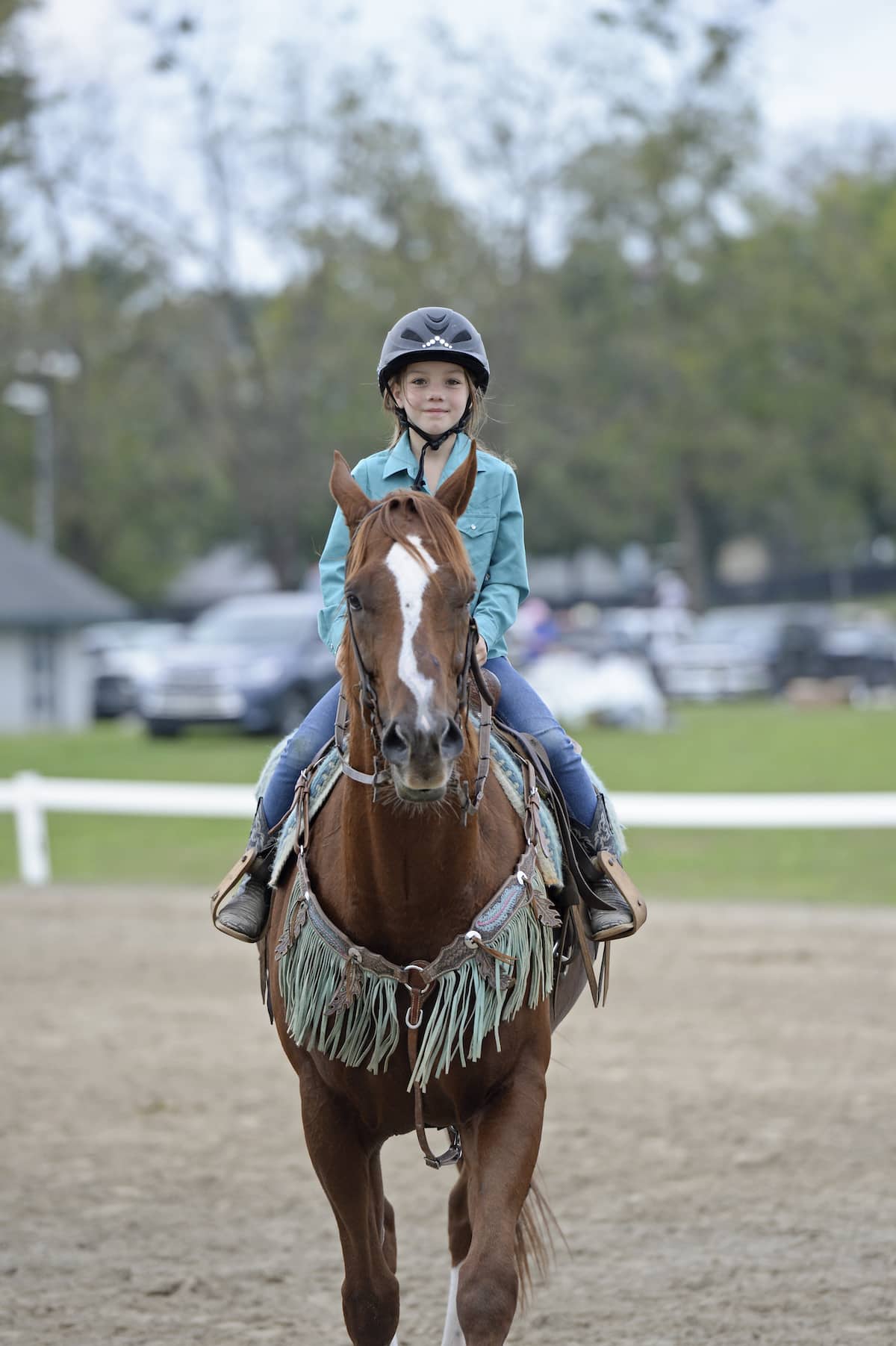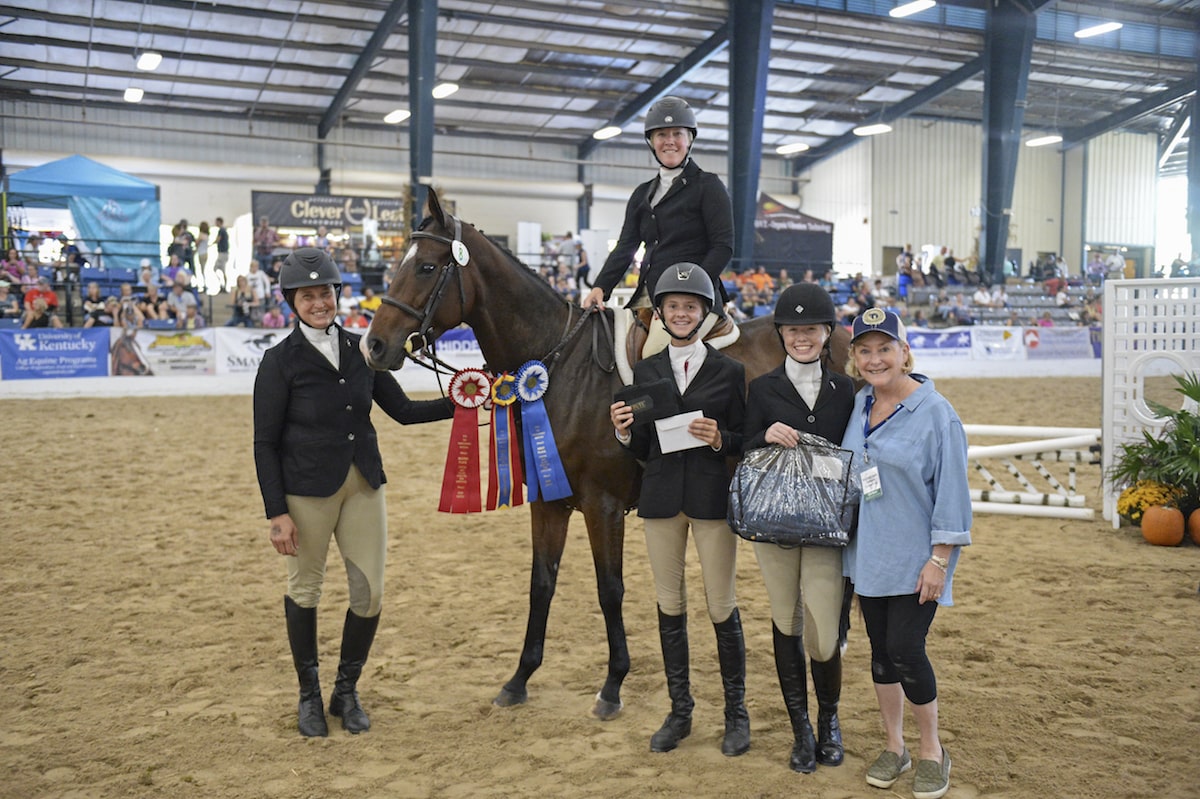Are OTTBs appropriate for novice riders? Here are some factors to consider.

Correct professional guidance and a good match of horse and rider are key if a novice equestrian is going to find success aboard an OTTB. Anne Litz photo
More and more people are considering off-track Thoroughbreds (OTTBs) as their next horses, thanks to their versatility and growing popularity. But are they suitable for anyone, including novice riders? Perhaps you’re considering getting a horse off the track but don’t know if you have the skill or experience level to retrain one. Where do you start? How do you determine if it’s the right time to get an OTTB? Can you do this alone, or do you need to enlist a veteran trainer’s help?
We’ll define “novice” in this article as either someone who is a beginner rider (having only ridden at walk/trot/canter/lope/over small jumps) or a more advanced rider with no exposure to horses off the track. It’s important to understand that there’s no one riding level or milestone that automatically makes someone an “expert” or ready to take on an OTTB. Skill, knowledge and experience all play enormous roles in determining whether an OTTB is a viable option when considering your next riding horse.
Recognizing and acknowledging where you stand on that spectrum is the first and most important step in your OTTB journey. If you fail to be realistic and address your own shortcomings, you could put yourself and your new horse in a frustrating, if not potentially dangerous, situation. As a result, that horse could be paying for your mistakes for years to come. If you are unsure about your abilities, seek out someone who has firsthand experience transitioning horses off the racetrack, and ask him or her to evaluate your riding. Our sources agree that any rider with no or limited experience with OTTBs, regardless of skill level, should have an experienced trainer guide them.
Potential Risks of Going it Alone
Many problems can develop quickly if an inexperienced handler is paired with an OTTB without any direction. Ashley Watts, owner/trainer at Liftoff Equestrian, in Versailles, Kentucky, has decades of experience riding and showing Thoroughbreds and works closely with CANTER Kentucky to retrain many of its horses. She emphasizes the need for correct guidance and a good match of horse and rider.
“Inexperienced riders can get injured, frustrated and lose confidence, among many other outcomes, if they don’t have assistance from an experienced trainer,” she says. “I have seen a horse deemed ‘unrideable’ because of the skills his rider lacked in the (retraining) process. This horse turned into a completely capable riding horse once he was put into a program with experienced riders, but with the beginner rider it was not going to be a successful outcome.”
Kimberly Godwin Clark, a United States Dressage Federation Silver Medalist with 30 years of experience galloping racehorses, is the author of New Track, New Life: Understanding and Retraining the Off-Track Thoroughbred. She operates the Thoroughbred Placement Resources, in Upper Marlboro, Maryland, and notes the value in finding a horse for a novice rider that is not directly off the track.
“I like to put a basic foundation of training on the horse for a novice rider,” she says. “I have seen countless horses who have serious training problems because they landed in the hands of someone who did not know what they were doing or did not have the guidance of someone experienced to help them. The result is often the horse is blamed and discarded, a new one is acquired, and the cycle repeats itself.
“It’s important to understand that racehorses have been handled by professionals who are confident and reassuring,” she adds. “Retirement is typically a racehorse’s first experience with novice handlers. To a retired racehorse, novice riders or trainers may appear afraid or hesitant or unpredictable, (which is) cause for alarm. The horse may react negatively and then be labeled a problem horse, when in reality the horse was just reacting to the human’s behavior. An experienced trainer, especially one with experience with retired racers, can explain this to the novice and show them how to interact with the horse in a positive way.”
Another factor to consider is the financial one. Horses off the track are often popular due to their affordability and easy availability. This is especially appealing to new equestrians, who might not understand the true financial impact of taking on such a project.
“Since these horses are cheap or even free and promoted that way, in many instances it’s very hard to get people (who have bought these horses because of their prices) to hire a trainer,” says Clark. “Since many of these people didn’t expect to pay money to train the horse, it’s hard to get them to admit they need to. Of course, they need the finances to do it.”
It behooves riders new to retired racers to get such a trainer on board right away. “It takes much longer to fix a horse than it does to correctly train him in the first place,” Clark says, and it can be even harder to convince already reluctant spenders to hire a trainer with the skills necessary to “fix” poorly restarted mounts later in the game.
Finding a Trainer

Join a Thoroughbred Makeover team to gain experience before acquiring your own ex-racer. Anne Litz photo
If you don’t already have a relationship with someone who has the expertise to help, what should you look for in a trainer? Find someone with a passion for the breed, who has patience for you and the horse and is a strong communicator who will give you useful feedback. Most importantly, look for firsthand exposure to Thoroughbreds and success transitioning them from the track.
“A trainer that is experienced with training OTTBs is crucial to the program developed for the horse,” Watts says. “If a trainer doesn’t understand what the horse has undergone at the racetrack, the quality of the new program may be lacking or missing some important factors.”
Clark emphasizes the importance of familiarity with how racehorses are trained and handled. “This is important because some behaviors that a pleasure or show rider may not like are normal, if not encouraged, at the racetrack,” she says. (A prime example is walking off during mounting.) “The experienced trainer will know that a horse exhibiting those behaviors isn’t being bad, he’s simply doing what he was trained to do. And the trainer will know how to correct them, if necessary.”
Educating Yourself
In addition to working with an experienced trainer, be a student and educate yourself about the OTTB world, retraining techniques and horsemanship. “Read articles and books about retraining, watch videos and symposiums,” Watts says. “Attend clinics about natural horsemanship, breaking, desensitizing, etc. Find a trainer that is knowledgeable and willing to let you observe and ask questions.”
She adds that riding as many different horses as possible will help you develop better feel in the saddle and assist you and your trainer in determining what type of horse — OTTB or otherwise — you need.
Additionally, exposure to track life and the retraining process can be invaluable, Clark says: “Volunteer at a rescue that specializes in OTTBs. Get a job at the racetrack. Volunteer or get a job with a trainer who works with retired racers.”
If you’re an OTTB lover but not ready to take one on yourself just yet, explore becoming part of a Thoroughbred Makeover team entry. This allows you to gain experience working with horses off the track, while learning under the guidance of more experienced horsemen, plus you’ll get to be a part of the Makeover.
Off-track Thoroughbreds have many excellent qualities that can suit nearly every type of rider. However, not every rider is immediately ready to work with one on their own. Some might need a horse with several years’ experience in a second career. Others might be ready to work with a recently retired racer under an experienced trainer’s guidance. Whatever your path, be honest with yourself, your trainer and your horse. You are responsible for his future.
“Every horse that comes off the track is an ambassador for the breed,” says Clark. “Each horse is either a reason to get a retired racer or a reason to never get a horse off the track.”
If you and your supporters determine an OTTB is a good fit for you, get ready for an exciting journey, and enjoy the ride.
This article was originally published in the Spring 2020 issue of Off-Track Thoroughbred Magazine, the only publication dedicated to the Thoroughbred ex-racehorse in second careers. Want four information-packed issues a year delivered to your door or your favorite digital device? Subscribe now!

